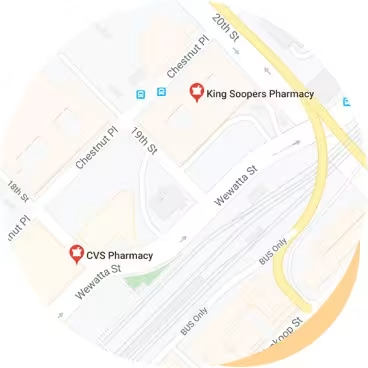- Chronic Care
- Back Pain
Sciatica
Sciatica (lumbar radiculopathy) treatment available online today
If you have back pain that may include sciatica (lumbar radiculopathy), consult with one of our board-certified primary care doctors online today. They will evaluate your symptoms and may be able to prescribe medications to help your back pain. Get a new prescription to treat sciatica or refill an existing prescription today.*
Book an appointmentQuick Relief for Sciatica Discomfort
Prevent Sciatica with simple lifestyle changes
Virtual appointments for Sciatica treatment
*Prescriptions are provided at the doctor's discretion. Learn more about our controlled substances policy and how to save up to 80% with our prescription discount card. PlushCare doctors cannot treat all cases of sciatica or low back pain. Our primary care physicians can conduct an initial evaluation of your symptoms but may need to refer you to a specialist or for in-person treatment. If you are experiencing life-threatening symptoms, seek emergency medical attention immediately by calling 911.

Learn about sciatica (lumbar radiculopathy)
Sciatica, also known as lumbar radiculopathy, refers to sciatic nerve pain. The two sciatic nerves are the largest nerves in the human body and run from the buttocks down the back of each leg. These nerves control the muscles in the lower leg as well as provide sensation to the back of the thigh, lower leg, and bottom of the foot. If these nerves are irritated or pinched, sciatic pain radiates along the same area that the nerve functions -- lower back through the buttocks and down each leg.
Approximately 40 percent of people in the U.S. experience sciatic pain at some point during their life. According to Cleveland Clinic, back pain is the third most common reason people seek medical attention.
Sciatica causes
The most common causes of sciatica are herniated discs or degenerative changes in the joints of the spine, both of which can compress the sciatic nerve and lead to pain. In rare cases, a tumor or disease, such as diabetes, can pinch or damage the sciatic nerve. Multiple risk factors can also increase your risk of sciatica, including:
Age
Changes in the spinal column, such as bone spurs and herniated disks, can lead to sciatic nerve issues.
Obesity
Excess body weight increases stress on the spinal cord, which can lead to a pinched nerve.
Occupation
Jobs that require driving for long periods, lifting objects, or twisting your body can hurt your sciatic nerve.
Sedentary lifestyles
People who sit for prolonged periods are more likely to experience sciatica.
Sciatica symptoms
Although patients may experience sciatica symptoms differently, some common symptoms include:
Mild or severe pain along the sciatic nerve
Numbness in the affected leg
Pins-and-needles sensations in the lower leg, foot, and toes
Pain that worsens with movement
Much more rare, but also more severe, symptoms may include:
Weakness in the leg or foot
Loss of bowel and bladder control

How to treat sciatica
Sciatica treatment provides pain relief and boosts mobility. In some cases, the pain will go away with self-care treatments. Other people, however, may need to see healthcare professionals to relieve sciatica. Some effective self-care treatments for sciatica include:
Applying hot and cold packs. Apply a cold pack for 20 minutes several times a day, and switch to a hot pack after the first few days. If you're still in pain, alternate between heating pads and cold packs to soothe your compressed nerve.
Take over-the-counter medication. Take medications to relieve pain and calm your irritated nerve. The most common over-the-counter medications for sciatica treatment, non-steroidal anti-inflammatory drugs (NSAIDs), include ibuprofen, aspirin, and naproxen.
Decrease heavy activity and perform gentle range of motion exercises and stretches. Take it easy and treat your body to some self-care with gentle stretches. Learn proper stretches and range of motion activities from wellness professionals to help with lower back pain.
When self-care measures don't relieve sciatica nerve pain, your healthcare professional may recommend the following treatments:
Physical therapy. A physical therapist can help you develop a stretching and exercise routine to reduce pain. Oftentimes, muscular stability and proper posture can alleviate pain and prevent flares significantly.
Prescription medication. Depending on the severity of your pain, your healthcare professional may prescribe medications to treat your symptoms.
Alternative therapies. Your healthcare provider may recommend alternative therapies, such as biofeedback, massage therapy, or acupuncture, to relieve sciatica pain.
Surgery. Only a small percentage of people with sciatica pain require surgery. If sciatica persists for a few weeks despite professional treatment, your doctor may refer you to a spine specialist to take detailed images, perform a physical exam, and determine the best treatment.
Sciatica medication
In addition to over-the-counter medications, prescription medications can help reduce sciatic nerve pain and soothe inflammation. Some prescription medications for sciatica pain include:
Muscle relaxers to ease muscle spasms
Antidepressants, such as tricyclic antidepressants, for chronic pain
Pain medications to relieve severe lower back pain

How to prevent sciatica
Although it's not always possible to prevent sciatica, simple lifestyle changes can help to lower your risk. Here are some self-care measures to protect your spinal nerve.
Make physical activity part of your routine. Your lower back muscles play a key role in posture. If you're experiencing sciatic pain, ask your healthcare provider about specific exercises for pain relief.
Practice proper posture. Choose chairs with lower back support. If you need some extra support, place a pillow in the small of your back.
Lift with your knees. Avoid lifting with your upper body if you're lifting objects. Instead, keep your back straight and bend at the knees.
Maintain a healthy weight. Carrying too much abdominal weight can lead to both a worsening sedentary lifestyle and also put stress on your back that can lead to injury and pain.

When to see a doctor for sciatica
If a two-week trial of self-care treatments fails to provide pain relief, it's time to see a doctor for sciatica pain.
You should seek immediate medical attention by visiting an ER or calling 911 if:
You experience unbearable pain that lasts more than a few hours
You lose feeling in the same leg
You lose bowel or bladder control
You experience sudden pain after experiencing physical trauma like a car accident or a fall
Related conditions to sciatica
The term 'sciatica' is often misused, and people often attempt to self-diagnose and self-treat the wrong cause of their pain. Some related medical conditions that can cause lower back pain include:
Spinal stenosis (narrowing of the spinal canal)
Sacroiliac joint dysfunction
Piriformis syndrome
Spinal cord tumors
Spinal infections
Cauda equina syndrome (compression of the spinal nerve roots)
Sciatica treatment FAQs
What is the best treatment for sciatica?
The best treatment for sciatica will vary depending on the severity of pain and the cause of pain. Your doctor may perform imaging tests and take a complete medical history to diagnose sciatica and determine the best treatment for you.
What is the best medication for sciatica?
Over-the-counter medications are often the best treatment option for acute sciatica. If you're experiencing chronic sciatica, your doctor may prescribe prescription pain medication to soothe your sciatic nerve.
What is the fastest way to heal sciatica?
Alternating between heating pads and cold packs can provide immediate pain relief. Ice packs help reduce pain and inflammation, while heat boosts blood flow to the sciatic nerve. Enrolling in physical therapy as soon as possible can also lead you toward the path of recovery and injury prevention.
Does sciatica go away on its own?
Acute sciatica often goes away with self-care treatments and does not require medical attention. Meanwhile, chronic sciatica often requires professional sciatica treatment and does not subside with self-care.
Without treatment, some cases of sciatica may lead to permanent nerve damage.
What causes sciatica to flare up?
The symptoms of sciatica may become worse if you sit or stand for long periods, lift heavy objects, or twist your body. Sudden movements, such as sneezing or coughing, can also worsen sciatica pain, according to Cleveland Clinic.
How long does sciatica last?
While acute sciatica can last anywhere from four to eight weeks, chronic sciatica involves persistent sciatica pain that lasts for more than eight weeks.
3 simple steps to request sciatica treatment today

Step 1
Book a sciatica treatment appointment.
Book a same day appointment from anywhere.

Step 2
Talk to your medical provider regarding your sciatica symptoms.
Visit with a doctor on your smartphone or computer.

Step 3
Pick up a prescription to treat sciatica, if provided
We can send prescriptions to any local pharmacy.
Sciatica treatment pricing details
How pricing works
To request sciatica treatment and get a new prescription or refill on your prescription, join our monthly membership and get discounted visits
Paying with insurance
Membership
$16.99/month
First month free
Visits
Copay
30 days of free membership
Same-day appointments 7 days a week
Unlimited messages with your Care Team
Prescription discount card to save up to 80%
Exclusive discounts on lab tests
Free memberships for your family
Cancel anytime
Visit price with insurance
Often the same as an office visit. Most patients with in-network insurance pay $30 or less!
We accept these insurance plans and many more:
Paying without insurance
Membership
$16.99/month
First month free
Visits
$129
30 days of free membership
Same-day appointments 7 days a week
Unlimited messages with your Care Team
Prescription discount card to save up to 80%
Exclusive discounts on lab tests
Free memberships for your family
Cancel anytime
Visit price without insurance
Initial visits are $129.
If we're unable to treat you, we'll provide a full refund.
Sciatica treatment resources
Sources:
PlushCare is dedicated to providing you with accurate and trustworthy health information.
Cleveland Clinic. Sciatica. Accessed on May 15, 2022. https://my.clevelandclinic.org/health/diseases/12792-sciatica#:~:text=Sciatica%20pain%20is%20caused%20by,time%20and%20self%2Dcare%20treatments.
John Hopkins Medicine. Sciatica. Accessed on May 15, 2022. https://www.hopkinsmedicine.org/health/conditions-and-diseases/sciatica
Mayo Clinic. Sciatica. Accessed on May 15, 2022. https://www.mayoclinic.org/diseases-conditions/sciatica/symptoms-causes/syc-20377435.
PlushCare content is reviewed by MDs, PhDs, NPs, nutritionists, and other healthcare professionals. Learn more about our editorial standards and meet the medical team. The PlushCare site or any linked materials are not intended and should not be construed as medical advice, nor is the information a substitute for professional medical expertise or treatment.